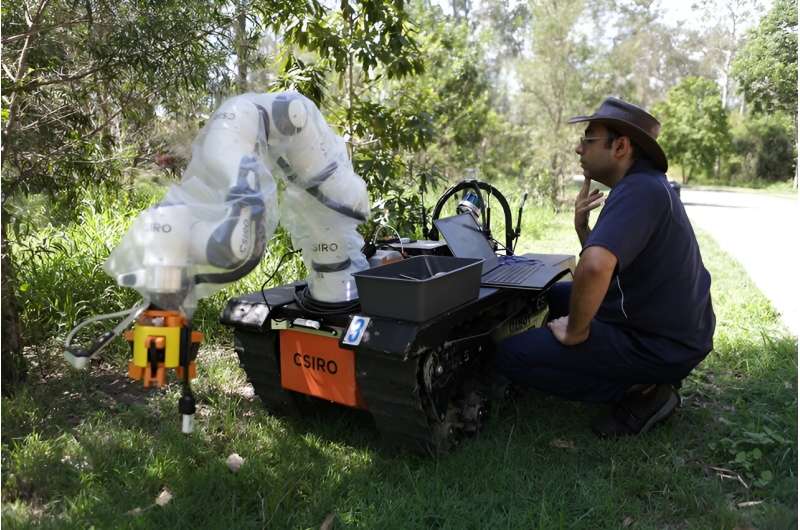This article has been reviewed according to Science X's editorial process and policies. Editors have highlighted the following attributes while ensuring the content's credibility:
fact-checked
trusted source
proofread
Future robots to stay one step ahead of bushfires

Bushfires can move at astonishing speeds. The land, amount of vegetation, and the weather all have a big impact on how a fire spreads. Staying one step ahead is no easy task, but our bushfire researchers are working on it.
Fire fighters need to know where bushfires are, how far and how fast they could spread, and how dangerous they could become. Especially when there's more than one fire to prioritize.
But getting on-the-ground information can often take fire fighters dangerously close to active fires. Drones can offer a view from the skies. But they battle smoke and winds, need permissions to fly, and have limited battery life.
That's why our researchers are part of the Silvanus Project, an international effort to design on-the-ground robots. Their job? To gather useful information while keeping fire fighters safe during bushfires.
Robots in front
Scientists from Data61's Queensland Centre for Advanced Technologies are working on robots that could travel into fire fronts. Some move on legs, and others on tracks. Once at the front, they can send back valuable information to fire fighting headquarters. This includes where a fire is, where it's heading, and how much fuel is in its path.
The technology is still in development. Last year our Data61 robotics team showed fire services how these robots could help during a bushfire. They gave a demonstration to representatives from Queensland Land and Wildlife Service, Firesticks Alliance, and Digital Earth Australia, as well as researchers and developers from The University of Queensland, Catalink and Venaka.
Robots fighting fires on the frontline
These robots will be able to navigate to and from fire fronts independently. They can capture images, geolocations, and other results. They transmit them back to a cloud-based platform, which authorities can monitor from afar.
On-board remote sensing lasers can also measure tree and leaf density. This helps to predict how much fuel there is in surrounding areas.
Senior experimental scientist Tom Lowe said the robots would be deployed in areas too dangerous for fire fighters to enter.
"Using this online platform, you can see a map of what the ground robots have found," Tom said.
"If you had a number of these ground robots scouting in front of fire, you'd have a tremendous amount of information at your fingertips. Then you could combine it with data from a drone overhead, and even crowd-sourced information from social media."
While the technology is still in development, in a matter of years these robots could tackle real fires.
"I don't expect we will see these working in active bushfires this year, but by the end of the decade I think it's very likely," Tom said.
"Twenty years ago, people wouldn't have expected aerial drones to be used in fire fighting like they are now. And they are probably 10 years ahead of ground robots."
International research effort
Cyber-Physical Systems Research Director Navinda Kottege said ground robots could save lives.
"These ground robots could change the way we fight dangerous bushfires," Navinda said.
"The ability to understand where fire fronts are and the fuel loads in the forest or bush—accessible via web platform in real-time—may prove invaluable for firefighters. And that is on top of the major benefit of not requiring firefighters to be near extremely dangerous fires."
The research is part of the EU's Project Silvanus. It includes researchers from Europe, Australia, Indonesia, and Brazil. Silvanus is an international effort to develop a climate-resilient forest management platform. It aims to prevent and suppress fires where needed.
The platform will support decision-making to help authorities be better prepared for fires. It will also help streamline the response when a fire breaks out.
The project brings together wireless communication, remote detection, and fire behavior modeling. It involves coordinating data from drones and ground robots into a single platform for fire authorities.
Our team continues to collaborate with Project Silvanus researchers in Czech Republic. Together, they are working on technology to coordinate many robots acting in a single system, like a swarm of insects.
The 'swarm robotics' technology will help a group of robots like ours work together to cover large areas and provide intelligence to off-site firefighters.


















